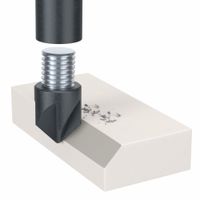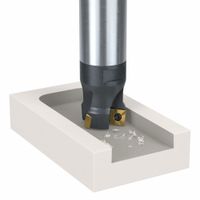Call +(254) 703 030 000 / 751 483 999 / 721 704 777
- Home
- Machining
- Indexable Cutting Tools
- Indexable Exchangeable Head Milling
.....Read More
Frequently Asked Questions
What are exchangeable-head milling tools?
Exchangeable-head milling tools are advanced cutting tools used in machining operations, designed to enhance efficiency and flexibility. These tools consist of a tool body and a detachable cutting head, allowing for quick and easy replacement of the cutting head without removing the entire tool from the machine. This modular design offers several advantages:
1. **Cost-Effectiveness**: By replacing only the worn-out or damaged cutting head instead of the entire tool, manufacturers can significantly reduce tooling costs. The tool body can be reused multiple times, extending its lifespan.
2. **Versatility**: Exchangeable-head milling tools can accommodate various cutting heads, each designed for specific materials or applications. This adaptability allows for quick changes between different milling operations, such as face milling, end milling, or slot milling, without the need for multiple complete tools.
3. **Reduced Downtime**: The quick-change capability minimizes machine downtime during tool changes, enhancing productivity. Operators can swiftly swap cutting heads, maintaining continuous production flow.
4. **Precision and Performance**: These tools are engineered to maintain high precision and performance. The secure connection between the tool body and the cutting head ensures stability and accuracy during machining, resulting in superior surface finishes and dimensional accuracy.
5. **Inventory Management**: With fewer complete tools required, inventory management becomes simpler. Manufacturers can stock a variety of cutting heads for different applications, reducing the need for extensive tool inventories.
6. **Sustainability**: By reducing waste through the reuse of tool bodies and minimizing material consumption, exchangeable-head milling tools contribute to more sustainable manufacturing practices.
Overall, exchangeable-head milling tools offer a flexible, cost-effective, and efficient solution for modern machining needs, catering to diverse industrial applications while optimizing operational efficiency.
How do indexable milling inserts work?
Indexable milling inserts are cutting tools used in milling operations, designed to be replaceable and repositionable. They are typically made from hard materials like carbide, ceramics, or cermets, which can withstand high temperatures and forces during cutting. These inserts are mounted on a tool holder or milling cutter body, which is attached to a milling machine.
The primary advantage of indexable inserts is their ability to be rotated or flipped to expose a fresh cutting edge without the need to remove the entire tool. This feature reduces downtime and increases productivity, as operators can quickly change the cutting edge without regrinding or resetting the tool. Each insert typically has multiple cutting edges, allowing for several uses before the insert needs to be replaced.
Indexable inserts are designed with specific geometries and coatings to optimize performance for different materials and cutting conditions. The geometry of the insert, including its shape, rake angle, and clearance angle, influences the cutting action, chip formation, and surface finish. Coatings, such as titanium nitride (TiN) or aluminum oxide (Al2O3), enhance wear resistance and reduce friction, extending the tool's life.
The inserts are secured in the tool holder using a clamping mechanism, which ensures stability and precision during milling. The tool holder is designed to accommodate the specific shape and size of the insert, providing the necessary support and alignment.
Overall, indexable milling inserts offer flexibility, cost-effectiveness, and efficiency in milling operations, making them a popular choice in various industries for machining metals, plastics, and other materials.
What are the benefits of using exchangeable-head milling tools?
#NAME?
How do you change the cutting head on a milling tool?
1. **Power Off and Safety**: Ensure the milling machine is completely powered off and unplugged. Wear appropriate safety gear, such as gloves and safety glasses.
2. **Secure the Machine**: Lock the spindle to prevent any movement. This can usually be done by engaging the spindle lock or using a wrench to hold the spindle in place.
3. **Remove the Current Cutting Head**:
- Loosen the drawbar: Use a wrench to slightly loosen the drawbar at the top of the spindle.
- Tap the drawbar: Gently tap the drawbar with a mallet to release the taper fit of the cutting head.
- Remove the cutting head: Once loosened, carefully remove the cutting head from the spindle.
4. **Clean the Spindle and New Cutting Head**: Use a clean cloth to wipe any debris or oil from the spindle and the new cutting head. Ensure both surfaces are clean to ensure a proper fit.
5. **Install the New Cutting Head**:
- Align the new cutting head: Position the new cutting head so that it aligns with the spindle.
- Insert the cutting head: Carefully insert the new cutting head into the spindle.
- Tighten the drawbar: Use a wrench to tighten the drawbar, securing the cutting head in place. Ensure it is tight enough to hold the cutting head securely but avoid over-tightening.
6. **Check Alignment and Security**: Verify that the cutting head is properly aligned and securely attached. Spin the spindle manually to ensure smooth operation.
7. **Test the Setup**: Power on the machine and perform a test run at a low speed to ensure the cutting head is functioning correctly without any wobble or unusual noise.
8. **Resume Operations**: Once confirmed, resume normal milling operations.
What applications are suitable for indexable milling tools?
Indexable milling tools are suitable for a variety of applications due to their versatility and efficiency. They are commonly used in:
1. **General Machining**: Ideal for operations like face milling, shoulder milling, and slotting, indexable tools are used in general machining for producing flat surfaces, shoulders, and slots with high precision.
2. **Automotive Industry**: These tools are used for machining engine blocks, transmission cases, and other components, providing high material removal rates and reducing cycle times.
3. **Aerospace Industry**: Suitable for machining complex components from materials like titanium and aluminum, indexable tools offer the precision and surface finish required in aerospace applications.
4. **Die and Mold Making**: Indexable milling tools are used for roughing and finishing operations in die and mold making, providing flexibility and reducing tool change times.
5. **Heavy Equipment Manufacturing**: In industries like construction and agriculture, these tools are used for machining large components, offering durability and efficiency.
6. **Energy Sector**: Used in the production of components for wind turbines, oil rigs, and power plants, indexable tools handle tough materials and large workpieces effectively.
7. **Custom and Prototype Manufacturing**: Their adaptability makes them suitable for custom jobs and prototype development, where quick tool changes and varied operations are required.
8. **High-Speed Machining**: Indexable tools are designed to withstand high speeds, making them suitable for high-speed machining applications that demand rapid material removal.
9. **Batch Production**: In batch production environments, the quick changeover of indexable inserts reduces downtime, enhancing productivity.
10. **Material Versatility**: They are effective on a wide range of materials, including steels, cast irons, non-ferrous metals, and superalloys, making them suitable for diverse machining tasks.
Overall, indexable milling tools are favored for their cost-effectiveness, ease of use, and ability to handle a wide range of machining operations across various industries.
How do you select the right milling insert for a specific material?
To select the right milling insert for a specific material, consider the following factors:
1. **Material Type**: Identify the workpiece material (e.g., steel, stainless steel, cast iron, non-ferrous metals, or superalloys). Each material has specific properties that influence insert selection.
2. **Insert Material**: Choose the insert material based on the workpiece. Common materials include carbide, ceramic, cermet, and cubic boron nitride (CBN). Carbide is versatile, while ceramics and CBN are suitable for hard materials.
3. **Coating**: Select the appropriate coating to enhance performance. Coatings like TiN, TiCN, and AlTiN improve wear resistance, reduce friction, and extend tool life.
4. **Insert Geometry**: Consider the insert shape, size, and edge preparation. Positive rake angles reduce cutting forces, while negative rake angles offer strength. Choose the geometry based on the desired surface finish and cutting conditions.
5. **Cutting Conditions**: Evaluate the cutting speed, feed rate, and depth of cut. These parameters depend on the material and machine capabilities. Ensure the insert can withstand the required conditions.
6. **Machine Capability**: Assess the machine's power, stability, and spindle speed. The insert must be compatible with the machine's capabilities to avoid damage and ensure efficiency.
7. **Application**: Determine the type of milling operation (e.g., face milling, shoulder milling, or slotting). Different operations may require specific insert shapes and geometries.
8. **Tool Life and Cost**: Balance the cost of the insert with its expected tool life. Higher-quality inserts may have a higher upfront cost but offer longer life and better performance.
9. **Manufacturer Recommendations**: Consult the manufacturer's guidelines and catalogs for recommendations based on extensive testing and expertise.
10. **Trial and Error**: Conduct test runs to fine-tune the selection, ensuring optimal performance and surface finish.
What are the differences between solid and indexable milling tools?
Solid milling tools are made from a single piece of material, typically high-speed steel or carbide. They are designed for precision and are often used for smaller, detailed work. These tools are generally more rigid, providing better accuracy and surface finish. However, once they wear out or break, they must be replaced entirely, which can be costly.
Indexable milling tools, on the other hand, have replaceable cutting inserts made from carbide or other hard materials. These inserts are attached to the tool body and can be rotated or replaced when worn, extending the tool's life and reducing costs. Indexable tools are versatile and can handle a variety of materials and applications, often used for larger-scale operations. They allow for quick changes and adjustments, minimizing downtime.
In summary, solid tools offer precision and rigidity, ideal for detailed work, but are more expensive to replace. Indexable tools provide versatility and cost-effectiveness for larger operations, with replaceable inserts that reduce downtime.


